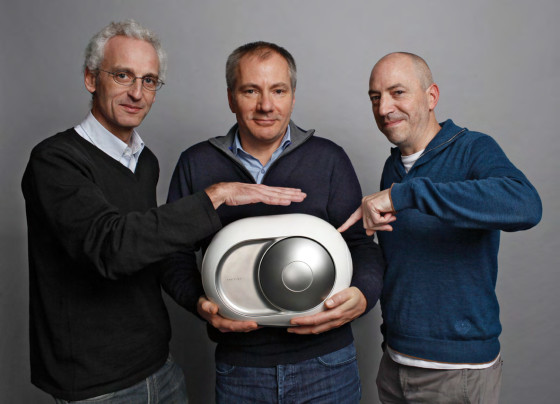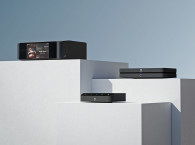Founded and based in Paris, Devialet is the renowned international leader for high-end amplifiers. From a building conceived by Gustave Eiffel and located in the heart of Paris, the best 40 acoustic, mechanic, electronic, computer and signal processing engineers work to invent the sound technologies of the future.

Among the hundred inventions by Devialet’s engineers, the company highlights three key concepts. ADH Intelligence, which is the “hybridisation” of digital and analog technologies using a powerful micro-processor, resulting in a more powerful, more distinct sound, with absolutely no distortion. SAM Processing, is the avant-garde technology which allows Devialet’s systems to adapt their signals to any type of speakers and emit perfect sound. And now Heart Bass Implosion (HBI), which is a technology specifically designed for the new Phantom speakers to emit ultra-dense sounds thanks to lateral beats under very high pressure.
After four years successfully selling their hybrid amplification concepts, Devialet surprised the world audio community with the announcement of the Phantom range of portable speakers - the fruit of 10 years of Research and Development in the Devialet Laboratories and close to 100 patents.
According to the company, Phantom is “a sound center, meaning, a system that receives music via Wi-Fi from your everyday devices (smartphone, tablet, computer…), it processes the signals and emits sound replacing your speakers.” They also claim “Phantom is the best sound system in the world.”

The idea for the Phantom range of speakers is much more than simply reinventing the wheel. For Devialet, it means, “inventing a better wheel” because the intention is for the Phantom to replace all stereo systems, docks, home-cinema… everything. According to Devialet, Phantom is “the only thing we will need.”
Phantom is also a 100% wireless product. It connects via Wi-Fi to all devices (smartphone, tablets, computers, TV…) and can be used on its own or connected to other Phantoms, creating a multi-room system in the house. Using a dedicated router (Dialog) the system creates a reliable CPL network and three hyper-powerful Wi-Fi networks of 300 megabits/second on 2,4 and 5 GHz.

The dedicated Dialog router creates a full wireless audio system in high resolution, and can control and synchronize up to 24 Phantoms. It connects to existing Internet routers in order to directly access music from the cloud. The Spark application allows to do live grouping, playing different music in each room, or filling a house with the same music for a big party. Apart from the wireless network, the solution uses a 1Gbps Ethernet, and Power Line Communication (PLC Homeplug AV2) connections. Each Phantom speaker also has an optical Toslink input and is able to share this input signal with any other Phantom on the network.
Thanks also to the EVO Platform (common to Devialet’s amplifiers), the Phantom speakers get better everyday. Once installed at home, Phantom will upgrade constantly, enhance its internal connections, connect to other Phantoms, react to our presence and improve continually.
Design and technology
The Phantom speakers combine all Devialet’s technologies. Because they are active speakers, the ADH Intelligence combines the refinement of Analog (or Class A) amplification with the power of Digital (or Class D - actually several class D amplifiers in parallel) amplification. The SAM Processing technology is then used to control the drive units to the perfection, reproducing the exact acoustic pressure recorded by the microphone. Together, the ADH Intelligence and SAM Processing create “the only engine in the world capable of driving what makes Phantom implosive: the Heart Bass Implosion” or HBI. The HBI concept consists of two Devialet high-excursion bass drivers, “moving in perfect symmetry in order to create a sound that has a physical impact and a density never before achieved.”

As Devialet explains, the benefits of ADH architecture result from the assistance of class D amplifiers, freeing the Class A amp while maintaining its linearity and musical qualities. Another benefit is that the output impedance of the ADH core is equal to the class A impedance divided by the current ratio of about 1:1000 between the class A and the class D amplifiers. That’s how an output impedance of about 1mΩ is achieved over the whole bandwidth, important to maintain high performance while controlling loudspeakers presenting a complex load.
Just ahead of the ADH amplification stage, another major technological advance from Devialet is used: the “Magic Wire”. The aim of the patented “Magic Wire” typology is to implement the DAC (Digital to Analog Converter) at the core of the class A amplifier, in order to reduce the parasitic, music-impeding phenomena - such as noise and distortion - to an absolute minimum. In practice, the output current of the highest performance DAC on the market (Texas Instrument PCM179X series) is directly converted into high-voltage without any processing in between: no operational amplifier, no current mirror.
Instead, the very elaborate leak-less path of the “Magic Wire” carries the original current of the DAC to an ultra-high linearity resistor (16.7kΩ, 0.01% precision), which operates the current/high-voltage conversion before entering into the class A. The “magic” comes from the fact that the guiding elements within the “Magic Wire” do not process the music, whilst providing high-voltage output. Besides, these guiding elements work at a stable power rate, hence constant temperature, which reduces thermal distortion to a non-measurable quantity.
Finally, the Phantom speakers emit sound using a new acoustic architecture the company calls, “Heart Bass Implosion” or HBI. “Heart Bass Implosion” because the Phantom speakers are more than 20x smaller in acoustic volume than what high-end audio speakers currently use to approach a similar deep bass performance. That means the maximum air pressure inside the enclosure is 20 times higher than in a conventional speaker box. Therefore the Phantom speaker drivers need to be able to create and resist extremely high pressure and vacuum inside the speaker box.
To ensure an omnidirectional emission and a uniform sound, the Phantom speakers are spherical in shape (to avoid diffraction along its surface) and use a sealed box architecture, for high efficiency at the lowest frequencies. They also feature highly efficient compact drivers, with very long diaphragm excursion capabilities, combining symmetric low-frequency units so as to cancel mechanical vibrations, with coaxial drivers for midrange and tweeter, and diaphragms that are flush with the surface of the sphere to reproduce higher frequencies. Devialet’s HBI woofers (26mm peak-to-peak) are “four times more powerful than the best woofers on the market of an equivalent diaphragm size, yet 6 times more compact and 6 times lighter”, they say. Each woofer can move a mass of more than 30kg, the company also claims.

Devialet also explains that the Phantom industrial design doesn’t use a single wire in its assembly, requiring only 10 parts/modules. The gasket that seals off the woofer enclosure has a diameter of 2.620mm, and it is compressed by a force of 1.2 tons to ensure sealing.
Devialet announced two Phantom models. The standard Phantom 750 watts speaker and the 3.000W Silver Phantom model. Both are able to respond from 16Hz to 20kHz (± 2dB). The first is rated at 99dB SPL and the Silver Phantom at 105dB SPL, both measured at 1m. The first is announced to cost $1,990 or 1690 Euros, while the Silver Phantom model will retail for $2,390 or 1990 Euros. The Dialog router will add a further $329 / 249 Euros to the system.
www.devialet.com







